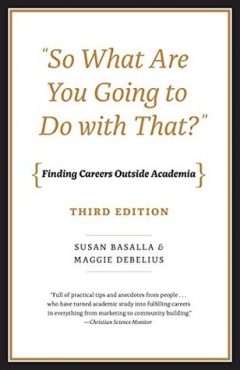So What Are You Going to Do with That?
Finding Careers Outside Academia
Third edition
By Susan Basalla & Maggie Debelius
University of Chicago Press, 2014
The starting point of So What Are You Going to Do with That? is the perennial question dreaded by many graduate students: what are you planning to do after graduate school? One piece of advice that resurfaces throughout this book is the antidote to that dread: the importance of thinking hard about future career plans during one’s tenure in a graduate program.
It seems simple enough. Notwithstanding the ostensible simplicity, most graduate students know all too well how easy it is to maintain rigorous engagement with all aspects of graduate studies—except for seriously planning for what lies on the other side of graduate school. A key reason for this lapse is the difficulty of drawing the contours of a radically ambiguous future. The authors repeatedly remind their readers that it is perfectly normal to feel helpless when facing such ambiguity, though the lack of certainty is no reason to give up on taking the initial steps. Borrowing an analogy from the novelists E. L. Doctorow, they explain that planning one’s career while in graduate school is “like driving at night. Your headlights only light up the road 30 feet in front of you, but that’s enough to get you all the way home.” Thus, when starting your career search, “embrace the ambiguity” and realize that while lived narratives may seem confused in the present, they do eventually gain distinct forms.
To emphasize the idea of career planning as a lived narrative in progress, the book is interspersed with personal stories of former graduate students who succeeded in making important (and ultimately rewarding) decisions with respect to their future careers. Some did so by experimenting with part-time work, others by pursuing interests outside of academia, some by taking a break from incessantly obsessing over their dissertations, and yet others through having difficult, honest, and necessary conversations with their advisers about how their current projects figure within their future plans.
In addition to telling real-life stories, So What Are You Going to Do with That? provides high-level career advice, technical tips (e.g. the fundamental differences between a CV and a resume, or a list of active verbs to use in resumes), and debunks common myths such as “no one would hire me because I have no skills.” Given the prevalence of this particular myth in the graduate student population, the pressing question then becomes, so, what are you going to do about that? Well, prove the myth wrong!
For more book reviews, visit our Bookshelf.